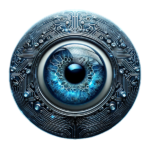Creating compelling AI-generated art involves more than just inputting a few keywords and hoping for the best. It requires a well-structured prompt that guides the AI in producing the desired image. In this blog post, we will break down the essential components of an AI art prompt, helping you craft detailed and effective instructions for your AI art projects.
Key Components of an AI Art Prompt
1. Subject
Primary Subject: This is the main focus of your image. It could be anything from a warrior to a futuristic city. The primary subject sets the stage for what the AI should prioritize in the image.
Secondary Subjects: These are additional elements that complement the primary subject. For instance, if your primary subject is a warrior, secondary subjects might include a dragon or robots. These elements add depth and context to your image.
2. Environment/Background
Setting: The overall scene or location where your subject exists. Examples include a post-apocalyptic wasteland or a magical forest. The setting provides a backdrop that frames the primary subject.
Details: Specific features within the setting that enhance the scene, such as crumbling buildings in a wasteland or ancient trees in a forest. These details add richness and context to the environment.
3. Action/Scenario
Activity: Describes what the subject(s) are doing. Are they fighting, exploring, or perhaps meditating? The activity brings dynamism and storytelling to your image.
Interaction: How the subjects interact with each other or the environment. For example, a scene might depict characters battling monsters or discovering hidden artifacts. This interaction adds layers to the narrative of the image.
4. Style
Art Style: The artistic approach or genre you want to emulate. Examples include cyberpunk, surrealism, or comic book styles. The art style dictates the visual language and aesthetic of the image.
Mood/Tone: The emotional atmosphere you want to convey. Is the scene dark and gritty, bright and whimsical, or something else? The mood sets the emotional context for the viewer.
5. Lighting and Color
Lighting: Describes the light source and its effects. Options might include dimly lit environments, sunlight streaming through clouds, or neon lights. Lighting significantly impacts the mood and readability of the image.
Color Palette: The specific colors or overall color scheme you want to use. It could be monochromatic, vibrant hues, or a mix. The color palette enhances the mood and visual appeal of the image.
6. Composition
Framing: How elements are arranged within the image. Are they centered, off-center, or following the rule of thirds? Composition guides the viewer’s eye and creates balance in the image.
Perspective: The angle and viewpoint from which the scene is depicted. Options include bird’s-eye view, first-person perspective, or low angles. Perspective adds depth and dimension to the image.
7. Additional Elements
Textures and Patterns: Describes surface details like rusted metal or intricate fabrics. These elements add realism and tactile quality to the image.
Special Effects: Any additional visual effects such as lens flare, bokeh, or motion blur. Special effects can enhance the drama and interest of the image.
8. Contextual Information
Narrative: Any background story or context that adds depth to the image. For instance, “A lone warrior on a quest for revenge” gives the viewer insight into the character’s motivation.
References: Specific cultural or historical references that influence the image. Examples include Victorian architecture or Japanese folklore. References provide additional layers of meaning and recognition.
Example Prompt Breakdown
Let’s put these components into practice with an example prompt:
Prompt: “A cyberpunk cityscape at night with neon lights, featuring a lone figure in a trench coat, rain pouring down, and holographic advertisements in the background, inspired by Blade Runner.”

- Subject: A lone figure in a trench coat.
- Environment/Background: A cyberpunk cityscape at night.
- Action/Scenario: The figure is walking through the rain.
- Style: Inspired by Blade Runner, cyberpunk genre.
- Lighting and Color: Neon lights, dark with vibrant colors.
- Composition: The figure is centered, cityscape in the background.
- Additional Elements: Holographic advertisements, rain effects.
- Contextual Information: Inspired by Blade Runner, evoking a sense of dystopian futurism.
By structuring prompts with these components, you can provide the AI with clear and detailed guidance, resulting in more accurate and interesting artwork. Whether you’re creating for fun, professional projects, or enhancing your creative portfolio, understanding the anatomy of an AI art prompt is key to unlocking the full potential of AI-generated art.
Happy creating!



0 Comments